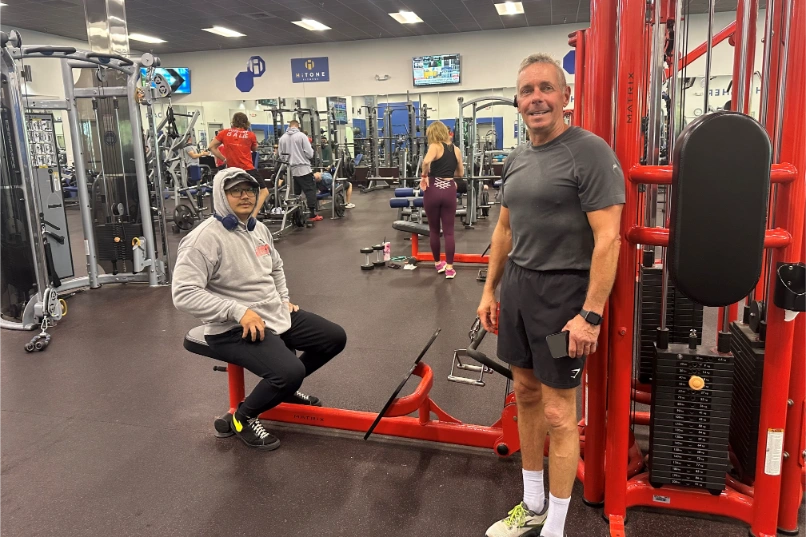Both circuit training and HIIT promise significant fitness benefits, from enhancing cardiovascular health to efficient fat burning, but they do so in uniquely different ways. This article delves into a side-by-side comparison of those two workouts, offering insights into which might suit your fitness goals, lifestyle, and preferences better.
What is circuit training?
Circuit training is a form of body conditioning that involves endurance training, resistance training, high-intensity aerobics, and exercises performed in a circuit. This training method targets strength-building and muscular endurance.
A “circuit” is one completion of all prescribed exercises in the program. When one circuit is complete, one begins the first exercise again for the next circuit. Traditionally, the time between exercises in circuit training is short, often with rapid movement to the next exercise.
The exercises within each circuit are separated by brief, timed rest intervals, and each circuit is separated by a longer rest period. The total number of circuits performed during a training session may vary from two to six, depending on one’s training level, fitness goals, and the intensity of the circuit.
If you’re just starting, you’ll be pleased to learn that circuit training is one of of the top 5 men’s fitness classes for beginners.
What is HIIT (High-Intensity Interval Training)?
High-Intensity Interval Training (HIIT) consists of short bursts of intense exercise alternated with low-intensity recovery periods.
Interestingly, the intense periods are performed at near-maximum effort and the recovery periods help maintain one’s ability to continue the workout at these intense levels without fatigue.
The duration of HIIT can vary from 10 to 30 minutes, and despite this relatively short duration, it can produce health benefits equivalent to twice as much moderate-intensity exercise. The key components of HIIT include exercises like sprinting, biking, jump rope, and other bodyweight exercises, which are designed to push the limits of your heart rate and endurance capacity.
If this training regimen is more down your alley, check out our HIIT full-body classes with weights for maximized results.
Comparing the benefits
Cardiovascular health: Both Circuit training and HIIT are excellent for improving cardiovascular health, but they do so differently. Circuit training involves longer periods of exertion and promotes endurance, while HIIT focuses on short, intense bursts that increase cardiovascular efficiency and can lead to improved heart health even more quickly than moderate-intensity exercise.
Fat loss and calorie burning: HIIT is often favored for fat loss because it burns a lot of calories in a short amount of time. However, Circuit training also promotes fat burning, especially when circuits are designed with few rest periods between exercises. Both training methods increase the metabolic rate for hours after exercise, known as the afterburn effect, but HIIT tends to have a slightly higher impact on this post-exercise oxygen consumption.
Muscle building and retention: Circuit training is particularly effective at muscle building and retention because it often incorporates a variety of strength training moves that involve different muscle groups. HIIT, while excellent for boosting metabolism and endurance, might not always focus on strength or hypertrophy. Depending on your fitness goals, incorporating weights into your HIIT workouts can help in muscle building.
Accessibility and suitability
When it comes to accessibility and suitability, both circuit training and HIIT offer unique advantages that cater to different fitness levels and preferences. Circuit training is highly adaptable and can be tailored to suit beginners through to advanced athletes. It can be performed in a gym with equipment or at home with minimal or no equipment. This versatility makes it a suitable option for those who might be intimidated by more complex exercises or those who prefer a structured workout that they can scale as their fitness improves.
HIIT, on the other hand, is intense and requires a certain level of fitness to begin with. It is suitable for individuals who are already somewhat active and are looking to push their limits. However, because HIIT workouts can be scaled down, beginners can start with less intense intervals and gradually build up their intensity as their fitness level increases. This makes HIIT a powerful tool for anyone looking to make significant fitness gains in a short period.
Final thoughts
Understanding the distinct benefits of circuit training and HIIT can help you choose the right workout for your fitness goals and lifestyle. If you’re in Morganton and curious about how these training methods could transform your fitness routine, HiTone Fitness is offering a fantastic opportunity. We’re excited to invite you to take advantage of a 3-day free pass to try out HIIT workouts at no cost.







